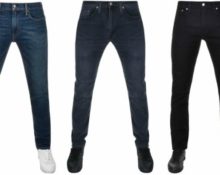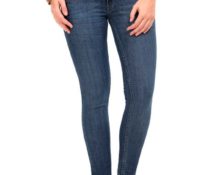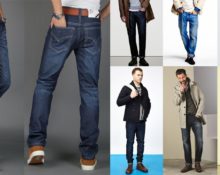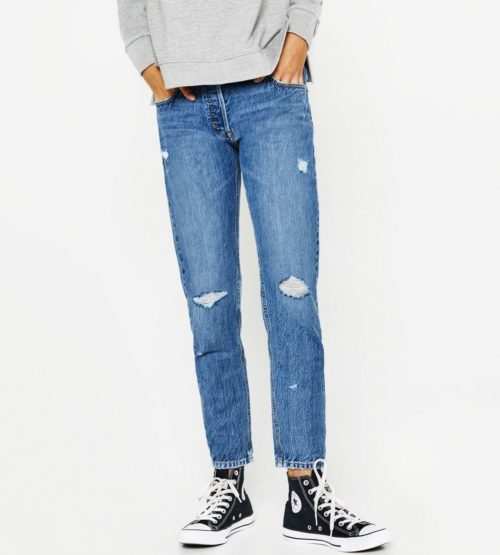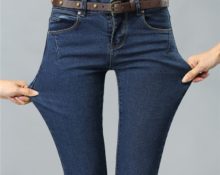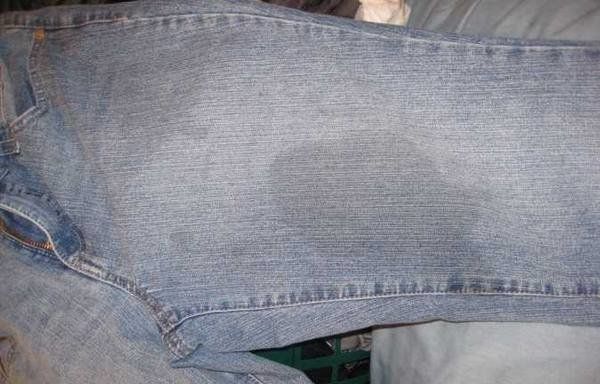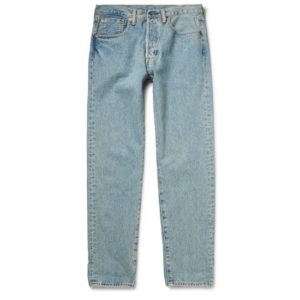 Jeans are the most popular clothing for all genders and ages. Over more than a century of history, they have been able to adapt to the characteristics of different types of female and male figures, fit into any style and at the same time maintain their individuality. The widespread use of denim trousers made it possible to create a unified system of their classification.
Jeans are the most popular clothing for all genders and ages. Over more than a century of history, they have been able to adapt to the characteristics of different types of female and male figures, fit into any style and at the same time maintain their individuality. The widespread use of denim trousers made it possible to create a unified system of their classification.
First of all, the label shows: waist size W/length L/silhouette fit/leg cut at the bottom cut/rise landing.
Waist circumference and length are calculated in inches, designated respectively - 30x34 or with the letters W30 L34. Some manufacturers do not indicate the length; by default it corresponds to the standard height values for each body type - from 165 to 190 cm.
Three main characteristics that differentiate types of jeans
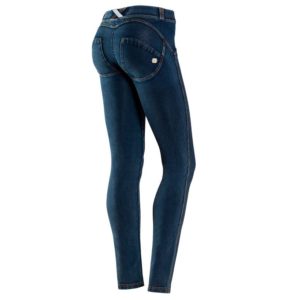 Landing (Rise) – reflects the distance from the navel or top button of jeans to the point where the inner crotches join. We call this value the seat height. There can be three types: high, low and average (regular).The fit is also divided into male and female, taking into account the peculiarities of the body structure of each sex.
Landing (Rise) – reflects the distance from the navel or top button of jeans to the point where the inner crotches join. We call this value the seat height. There can be three types: high, low and average (regular).The fit is also divided into male and female, taking into account the peculiarities of the body structure of each sex.
Silhouette (Fit) – cut the entire product from top to bottom, in some cases from the waist to the knee. According to Fit, you can judge the degree of fit of jeans to the body, its design and model features. Since styles are intellectual property, manufacturers can give trousers of the same silhouette different names, most often this applies to new products.
The cut of the lower part of the trouser leg (Cut or leg) – determines the width of the bottom of the product: tapered, straight or flared.
Types, name and originality of jeans according to fit features
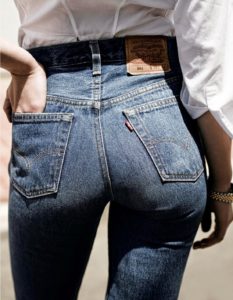 High (High-wasted rise) – with a belt above the waistline, visually increase the length of the legs. Mostly suitable for women with a normal and thin build.
High (High-wasted rise) – with a belt above the waistline, visually increase the length of the legs. Mostly suitable for women with a normal and thin build.
Average (Regular rise, ohoriginal rise or medium rise) – natural fit that suits all body types, men and women. Depending on the style, it can close or open the navel:
- regular rise or medium rise – nowadays considered standard, the belt is located slightly above or at the level of the upper part of the pelvic bones;
- original rise – strictly along the waistline, so far it is perceived as a high-waisted model, although it is not one.
Retro models (High rise) can also be classified as medium seat height. Their belt button is located exactly at the level of the navel, but the cut is significantly different from the modern one.
Low (Low rise or mid rise) – The belt in such models is located below the medium rise, but is held at the level of the pelvic bones above the pubic area. A common fit for jeans from the early 2000s. At the peak of their popularity, they were worn with short tops or sweaters that did not cover the naked body at the waist and upper hips. Today it is a comfortable design for overweight people and those with beer bellies.
 Greatly underestimated (Ultra low rise) – The upper edge of the jeans is on the lower part of the pelvic bones, the pubic area is practically not covered. In the first decade of the 2000s, only brave owners or those with ideal shapes could afford such a fit. Ultra low rise these days can be found extremely rarely.
Greatly underestimated (Ultra low rise) – The upper edge of the jeans is on the lower part of the pelvic bones, the pubic area is practically not covered. In the first decade of the 2000s, only brave owners or those with ideal shapes could afford such a fit. Ultra low rise these days can be found extremely rarely.
With a long codpiece or bloomers (Saggi fit) - with a lowered crotch seam, increasing the height of the seat up to the knee. The waistline can range from medium to low. With a small volume, the trouser style can be afforded by people of any build, but with height not lower than average. Ladies are recommended to wear with heels to visually lengthen their legs.
Important! If the label says Shrunk-to-fit, the jeans will only fit true to size after the first wash. Pre-shrunk – do not shrink.
Types, name and originality of jeans by silhouette
Standard (Regular or Classic fit) – Versatile straight jeans with an optimal fit, leaving space between the skin and the fabric. Suitable for all types of male and female figures, emphasizing advantages and hiding disadvantages. Can be combined with any type of summer and winter shoes.
There are:
- Easy fit – classic jeans, tight-fitting hips and slightly tapered at the ankle, the waistline is slightly below the natural line (regular rise or medium rise).
- Comfort fit – a looser model, with legs straight from mid-thigh, meeting a natural or high waistline.
- Five-pockets – five-pocket model Levi's 501. Full-length straight jeans with a wide original rise waistband.
- Sta Prest – retro jeans with an “eternal” arrow, which are shaped like regular classic trousers.
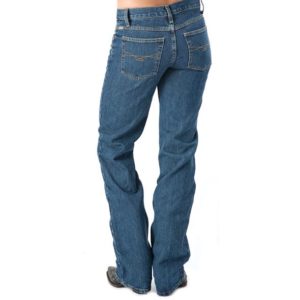 Free (Relaxed fit) – jeans with greater freedom of fit, fit at the waist or hips. Comfortable, do not restrict movement, suitable for any gender and age. They allow you to use warm underwear in cold weather and organically combine with many types of winter outerwear.
Free (Relaxed fit) – jeans with greater freedom of fit, fit at the waist or hips. Comfortable, do not restrict movement, suitable for any gender and age. They allow you to use warm underwear in cold weather and organically combine with many types of winter outerwear.
When classic models of your size are tight in the hips, loose-fitting jeans serve as an excellent replacement. Ideal choice Relaxed fit and for athletes with developed quadriceps: cyclists, bodybuilders, weightlifters.
Overly loose (Loose, Antifit or Baggy fit) - such styles are also called baggy. Jeans fit perfectly with style "oversized" when The product looks a couple of sizes larger than required.
The silhouette has become a distinctive feature of the image of a modern musical informal rapper or street sports fan:
- Loose fit – tube jeans, fit quite tightly along the hips and are spacious along the entire remaining length, the legs at the bottom are so wide that they cover the toes of the shoes.
- Antifit or Buggy fit – extremely wide trousers with an elongated codpiece, which gives them the appearance of slightly lowered trousers.
- Bib - baggy jumpsuit with straps.
Worn with boots or sneakers in combination with various sports items - from T-shirts, hoodies, sweatshirts, sweatshirts to warm jackets.
Important! Baggy fit may initially have a deliberately wide waist volume that does not correspond to standard sizes. An increase is given for a fashionable silhouette.
Boyfriends - an exclusively ladies' version of jeans that imitate a men's cut. Loose, a little baggy, as if borrowed from an older brother or friend. Suitable for different body types, but they show crooked legs.
According to the figure (Slim, Skinny or Tight fit) – tight-fitting skinny jeans of varying degrees of fit. Typically shorter in length than other silhouettes, denim necessarily contains elastic fibers. Worn by both men and women of normal and thin build.
- carrots (Carrot fit or jeans chinos) – trousers that are loose at the hips and tapered at the bottom, shaped like a carrot. Volume at the waistband is created with the help of folds and tucks. The belt line is at a natural level.
- pipes – the shape is similar Carrot fit, but the fit is low, at the hip line;
- cigarettes or pencil (Tight fit) – straight, tapered jeans, the legs of which resemble the shape of cigarettes or pencils and have a slight looseness of fit.
- tight-fitting (Slim fit) – jeans fit tightly at the waist and hips down to the knee, tapering from the knee to the ankle, but having a little freedom in this interval.
- "in the stick" (Skinny fit) – “second skin”, trousers with a full fit along the entire length of the product from the waist to the ankles.
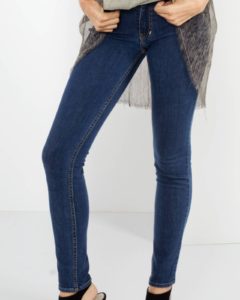 Tight jeggings ( jeggings) – maximum-fitting trousers that follow the smallest curves of the body. A hybrid of leggings and jeans. They are made from denim with a large addition of elastane or entirely from synthetic stretch fabrics. Suitable for slender people with ideal leg shape.
Tight jeggings ( jeggings) – maximum-fitting trousers that follow the smallest curves of the body. A hybrid of leggings and jeans. They are made from denim with a large addition of elastane or entirely from synthetic stretch fabrics. Suitable for slender people with ideal leg shape.
Joggers or bananas - the result of crossing classic jeans with sports sweatpants. Tight-fitting at the hips, narrow at the ankles and spacious at the knees. The bottom can be gathered with elastic or a drawstring. They were most popular in the 90s of the last century.
Types and uniqueness of jeans according to the cut of the lower leg
Based on the cut of the bottom of jeans, products are usually classified into three types, although there is a wide variety of variations in volume and cut.
Straight (Straight cut) – have straight or slightly tapered trouser legs. The width of the bottom may vary. Models, except Sta Prest, can be worn with or without lapels, depending on fashion. Classic shape that goes well with any type of shoe.
Tapered (Tapered cut or tailored leg) – from slight narrowing to maximum, like Skinny fit. This bottom is close to both sports style and business suit options.
Flare – implies extension from the knee or hip. Hides low buttocks and visually reduces the size of the feet. There are several types.
- Boot cut – the most ancient flared with an extension from the knee; at the bottom of the trousers they have the same width as at the hips. Landing on the hips. This cut was worn by cowboys of the Wild West.
- Flare cut – have a medium fit to the knee or mid-calf with widening towards the bottom. The fit is always below the natural waistline.
- Bell bottom – a hit of the 70s, tight-fitting jeans that widen greatly from the knee line.
- Flare from the hip - slight or significant widening of trousers from the middle of the thigh, sometimes looks like a culotte skirt.
Cropped and ripped jeans, their features
Cropped jeans with flares, tapered and wide leg are popular these days. Length varies from mid-calf to ankle. Playing with length refreshes the look, but requires caution, as it visually shortens the legs. Experts advise wearing heels and carefully choosing shoes by color.
Equal cut, cuts, natural fringe, different intensity of abrasion look organically and are combined with different styles, on different volumes and lengths of jeans. The exception is Sta Prest and other retro models.
Characteristics of jeans by fabric characteristics
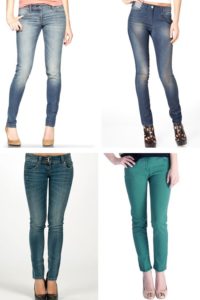 Classic denim is a natural cotton fabric with a twill weave (twill) from dyed and undyed threads. Today only classic models are made from it. In pursuit of the perfect fit and fit, most denim fabrics contain elastic fibers. Materials vary in density: summer or winter, colors and patterns.
Classic denim is a natural cotton fabric with a twill weave (twill) from dyed and undyed threads. Today only classic models are made from it. In pursuit of the perfect fit and fit, most denim fabrics contain elastic fibers. Materials vary in density: summer or winter, colors and patterns.
In addition to raw natural denim, they use:
- chambry – thin light denim fabric;
- broken twill – jeans with a herringbone pattern;
- acre – undyed jeans;
- stretch – jeans with the addition of elastane or dupont (lycra);
- gin - jeans made from threads of the same color.
Recently, combinations of different textures and the use of materials that are not typical of the traditional idea of jeans - leather, silks and even lace. You can guess the pedigree only by the cut and characteristic design of the pockets.
Varied colors. Models made of dark denim in blue shades coexist on the shelves with red, olive, yellow, purple, gold, quail eggs or fuchsia. White color is very popular in summer styles.The appearance of a new shade or color in a trend is immediately reflected in the collections of the new season.


 0
0